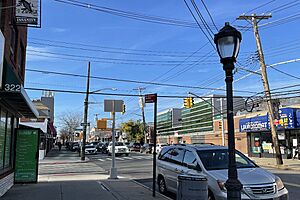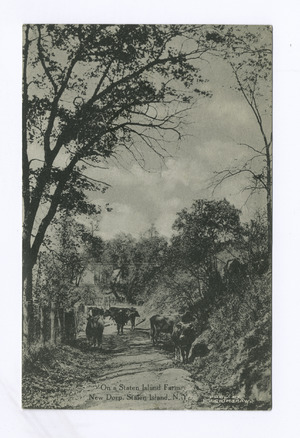New Dorp, Staten Island facts for kids
Quick facts for kids
New Dorp
|
|
|---|---|
|
Neighborhood of Staten Island
|
|

New Dorp Lane
|
|
| Etymology: "new village" in Dutch | |
| Country | |
| State | |
| City | |
| Borough | |
| Community District | Staten Island 2 |
| Established | 1671 |
| Area | |
| • Total | 7.46 km2 (2.881 sq mi) |
| Population
(2011)
|
|
| • Total | 28,225 |
| • Density | 3,782.6/km2 (9,796.9/sq mi) |
| Economics | |
| • Median income | $80,412 |
| Time zone | UTC−5 (Eastern) |
| ZIP Codes |
10306
|
| Area code | 718, 347, 929, and 917 |
New Dorp is a neighborhood on the South Shore of Staten Island, New York City, United States. It's a busy area with lots of shops and places to go.
New Dorp got its name from early Dutch settlers. The name is an English version of "Nieuw Dorp," which means "New Village" in Dutch. It was one of the first European settlements in the New York City area.
Historically, New Dorp was a very important town on Staten Island. It became part of New York City in 1898. In the 1960s, New Dorp grew a lot as more houses were built. Even today, it's a major center for shopping and transportation on Staten Island.
The famous Vanderbilt family has strong ties to New Dorp. Many family members are buried in the Moravian Cemetery here. This is the largest and oldest active cemetery on Staten Island.
New Dorp is part of Staten Island Community District 2. Its ZIP Code is 10306. The New York City Police Department's 122nd Precinct patrols the area.
Contents
History of New Dorp
New Dorp was once home to the first county seat of Richmond County. This area was called Stony Brook.
In 1667, the Dutch Republic gave their colony of New Netherland to England. This happened after the Second Anglo-Dutch War. The English renamed the colony the Province of New York. In 1670, the local Native Americans, mainly the Lenape tribe, gave up their claims to Staten Island to the English.
New Dorp was founded in 1671. The English expanded an older Dutch settlement called Oude Dorp (now Old Town). New lots were created along the South Shore. These new lots were settled mostly by Dutch families. They called it Nieuwe Dorp, meaning "New Village." This name later became "New Dorp."
The new village grew into one of the biggest and most important settlements on Staten Island. During the American Revolution, British forces used New Dorp as a base. They were preparing to attack American-held New York City. The Rose and Crown Tavern in New Dorp was even a British military headquarters for a while. It was owned by the uncle of Cornelius Vanderbilt.
In the late 1800s, members of the famous Vanderbilt family lived in New Dorp. Many of them are buried in the Moravian Cemetery. On January 1, 1898, New Dorp became part of New York City. This happened when all of Staten Island joined the city as the Borough of Richmond.
The Vanderbilt farm later became Miller Air Field for the U.S. Army. In the 1970s, it became part of Gateway National Recreation Area. New Dorp remained a main town on Staten Island until the 1960s. That's when New York City's suburbanization caused the island to grow rapidly. Many new houses were built, and towns like New Dorp became part of the larger city area.
Even so, New Dorp kept its unique feel. Today, it's one of the busiest shopping areas on Staten Island. In the 1960s, many shopping centers were built along Hylan Boulevard. The largest of these was Hylan Plaza, which opened in 1966.
In 1960, a plane crash happened over New Dorp. It was a very sad event.
Fun and Entertainment
The Lane Theater in New Dorp opened on February 10, 1938. Its first movie was One Hundred Men and a Girl. The theater was designed to look like an "atmospheric theater." It used special lighting and projected images to create a unique experience. The ceiling was also beautifully painted.
The theater cost about $100,000 to build and could seat 600 people. It had the newest sound system and was cooled by refrigeration. In 1977, it was updated and could seat 550 people. The theater's inside has been a landmark since 1988. This means it's a special building that needs to be protected.
Starting in 1998, the Lane Theater hosted concerts, including one by a young Eminem. It was also a nightclub called "The EleMent" for a few years. In 2009, it became Uncle Vinnies Comedy Club. Since 2012, the building has been home to the Crossroads Church.
Fire Safety
The New York City Fire Department (FDNY) helps keep New Dorp safe. Engine Company 165/Ladder Company 85 is located at 3067 Richmond Road. Engine Company 165 is special because it has gear to handle hazardous materials. Its team also gets extra training for these situations.
Post Office and ZIP Code
New Dorp is in the ZIP Code 10306. The United States Postal Service has a post office here. It's called the New Dorp Station post office and is located at 2562 Hylan Boulevard.
Parks and Green Spaces
Dugan Park, also known as Gerard P. Dugan Playground, is a large park in New Dorp. It was named after a community leader when it was updated in 1974. Many people call it "Tysens Park" because it's located at an intersection with Tysens Lane.
The park is often busy with students from nearby schools and people from the Tysens Park Apartments. It has a big field with two baseball/softball fields. Leagues often play games there on summer weekends. There are also two basketball courts, handball courts, and jungle gyms for everyone to enjoy.
Education in New Dorp
New Dorp has a good number of college-educated residents, similar to other parts of New York City. About 40% of adults aged 25 and older have a college degree or higher. Most students in New Dorp and Mid-Island do well in math. The number of students doing well in math went up from 49% in 2000 to 65% in 2011.
Fewer elementary school students in New Dorp miss a lot of school days. Only 15% of elementary students missed twenty or more days in a school year. This is less than the city average. Also, 87% of high school students in New Dorp graduate on time. This is better than the city average of 75%.
Schools in the Area
The New York City Department of Education runs these public schools near New Dorp:
- PS 41 New Dorp (for grades PK-5)
- New Dorp High School (for grades 9-12)
- Staten Island Technical High School (for grades 9-12)
New Dorp Library
The New York Public Library (NYPL) has a branch in New Dorp at 309 New Dorp Lane. It's one of the busiest libraries on Staten Island. Local residents started this one-story branch in 1907. It was first called the New Dorp Community Library.
The NYPL started sending books to the New Dorp branch in 1909. It officially became an NYPL branch in 1926. The library was updated in 2000. The New Dorp branch will close temporarily in summer 2024 for big renovations. These updates will improve the heating, ventilation, and air conditioning systems. The roof will also be rebuilt.
Getting Around: Transportation
New Dorp has its own train station on the Staten Island Railway. It's called the New Dorp station and is located at New Dorp Lane and New Dorp Plaza.
You can also get around New Dorp using many bus routes. These include local and limited buses like the S57, S74, S76, S78, S84, S86. There's also the S79 Select Bus Service bus. For longer trips, you can use express buses like the SIM1, SIM5, SIM6, SIM7, SIM9, SIM10, SIM11.
Famous People From New Dorp
Many interesting people have lived in or are connected to New Dorp:
- Nathaniel Lord Britton: A botanist and the first director of the New York Botanical Garden. He was born in New Dorp Beach. His old house, The Britton Cottage, is now preserved at Historic Richmond Town.
- Gustav A. Mayer: He invented the Nilla wafer! He lived in a mansion in New Dorp.
- Jacques Reich: A portrait etcher.
- Eddie Kaye Thomas: An actor who grew up in New Dorp.
- George Washington Vanderbilt II: A descendant of Cornelius Vanderbilt. His family owned a lot of land in New Dorp.
- Susan Molinari: A former city councilwoman and congresswoman.
- Robert Funaro: An actor known for his role in The Sopranos.
- Bobby Gustafson: Former lead guitarist of the band Overkill.
|
See also
 In Spanish: New Dorp (Staten Island) para niños
In Spanish: New Dorp (Staten Island) para niños


